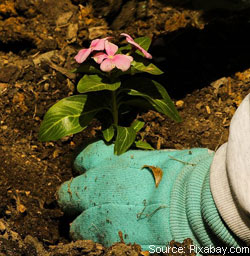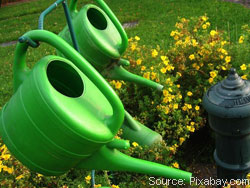 Whether you've just moved into a new home, or just want to liven your backyard, growing a garden can be a great project to take on.
Whether you've just moved into a new home, or just want to liven your backyard, growing a garden can be a great project to take on.
Growing any plant, whether it's vegetables or flowers, requires some planning. Spring is always a good time to begin growing and digging, although, planning your garden can also begin before all the snow has finished melting.
During the summer, gardeners spend most of the time watering, weeding and watching young plants grow. Fall is a good time to plant trees, shrubs, bulbs and some perennials.
Want to know more about planning your first garden? Read the following tips to get started.
Where to begin
Is it going to be a vegetable garden? An herb garden? A flower garden?
If you decide you'd like to have a flower garden, do you want to plan annuals -flowers you'll have to replant each year - which will have color most of the summer? Or do you prefer perennials - flowers that will come back each year - which will bloom for a short amount of time?
When thinking of where to plant your garden:
- Keep in mind that almost all vegetables and flowers need about six hours of full sun each day.
- Watch how the sun moves across whatever spot you choose, it may receive more sun than you thought.
- Put the garden somewhere you won't be able to ignore it. Near the back door, by your mailbox or right outside the window you look at while in the living room.
TIP: Try your best to plant your garden close enough to a water spigot so you won't have to drag a hose too far.
Clear the ground
Get rid of the sod covering the area you plan on planting. If you want quick results, you can dig it out the section, but it's easier to smother it with a newspaper. A layer of five newspaper sheets or corrugated cardboard is usually thick enough to smother the unwanted grass and weeds. Cover the newspaper with a 3-inch layer of compost or a combination of potting soil and topsoil on the newspaper and wait. This will take about four months for the newspaper and compost to decompose.
TIP: If you don't want to wait, or the area is covered in weeds, you're better off digging the area out.
Improve the soil
 Soil will usually need a boost. An easy solution is to add organic matter. Add a 2- to 3-inch layer of compost, decayed leaves, dry grass clippings or old manure. If you've dug out the section, till the organic matter into the soil, if not, placing a layer of the organic matter will suffice and will work its way into the soil in a few months.
Soil will usually need a boost. An easy solution is to add organic matter. Add a 2- to 3-inch layer of compost, decayed leaves, dry grass clippings or old manure. If you've dug out the section, till the organic matter into the soil, if not, placing a layer of the organic matter will suffice and will work its way into the soil in a few months.
Digging
Digging will loosen the soil so the plants' roots can penetrate easier. However, digging when the soil is too wet or too dry can ruin the structure. The best time to dig up and loosen the soil is when it is moist enough to pack into a ball but is dry enough to fall apart when dropped.
Turn up the top eight to 12 inches of soil and mix in the organic matter with either a garden shovel or a gardening fork.
TIP: For vegetable gardens and annual flowers' beds, turn the soil only once a year in the spring before planting.
Choosing the plants
You can spend time browsing through catalogs or you can browse the aisles of your local garden store before deciding on what to plant in your garden, but it's important to remember your climate, your soil and the amount of sunlight in your garden.
Some easy-to-grow plants for beginners include:
- Annual flowers: cosmos, marigolds, impatiens, geraniums, sunflowers and zinnias.
- Perennial flowers: Russian sage, lamb's ears, black-eyed Susans, purple coneflowers, pansies and daylilies.
- Vegetables: lettuce, peppers, tomatoes and cucumbers.
Planting
Some plants, such as kale and pansies, can tolerate the cold weather so feel free to plant them in autumn or late winter. Tomatoes and many annual flowers shouldn't be planted until after the threat of frost has entirely passed over your area. Mid-spring and mid-autumn are good times to plant perennials.
Water
Water is essential to the life of your seedlings. Never let your seedlings dry out, so water them daily while they are small and taper off as they grow larger.
Water slowly and deeply so the water soaks in instead of running off into the street. To minimize evaporation, water your garden in the morning.